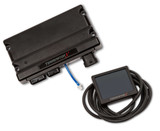Building a Valvetrain for Your 5.0
Bolt-on parts like bigger throttle bodies and higher flowing exhaust components can increase power, but at some point, they’re held back by the limits of your 5.0’s valvetrain. With the right upgrades, you can get more air and fuel into the engine and push exhaust gases out faster, reaping huge improvements in power.

How the Mustang 5.0’s Valvetrain Works
The valvetrain opens and closes the valves, letting air and fuel in during the
intake stroke and burnt gases out during the exhaust stroke. During the
compression and ignition strokes, the valves are kept closed for maximum
compression and power production.
The 5.0 is an overhead valve engine, which means it has a single camshaft
located directly above the crankshaft. As the camshaft spins, the lobes on its
surface push up against the lifters, also called tappets, which in turn push up
on the push rods. The rocker arms are mounted on the head in a way that lets
them rock back and forth like a see saw: as the push rod pushes up on one side,
the other side pushes down on the valve spring, opening the valve. Once the cam
lobe spins past the lifter, the lifter rocks back and the spring pulls the
valve up against the top of the combustion chamber, sealing it.
Upgrading these components lets more fuel and air enter the combustion chamber,
making it easier to get the exhaust gases out of the cylinders, and can help
keep the valvetrain working at high engine speeds.
Camshafts

As with setting up the intake and exhaust, picking the right camshaft is a
matter of maintaining velocity: a cam profile that opens the valves for a
longer duration and pushes them out further increases flow at high RPM, but it
can also reduce power at low RPM. Radical cams can have such poor performance
at low RPM that the engine will have difficulty idling and producing enough
vacuum to operate the brake booster, making them impractical for street use.
How much duration and lift should your new cam have? Getting the right
combination can be confusing, which is why we’ve designed our cams for specific
uses, working with popular parts combinations from nearly stock 302s to bored
and stroked small blocks with high flow heads and exhaust. Our offerings range
from the smooth idle and low-end grunt of our street-focused N-412 to the supercharger-ready
B-41. Each
product page lists of required parts as well as recommendations to get the most
from the cam profile complete with our own in-house dyno tests.
Just changing the camshaft? AFM makes a set of tools that keep the lifters from
falling down when sliding the old camshaft out, eliminating hours of labor to
take the lifters out of the motor.
Lifters and Push Rods
Aftermarket lifters are designed to handle hard driving with high quality
materials and added oil channels to ensure full lubrication. Likewise,
aftermarket push rods benefit from better machining, smoother oil channels and
higher grade metals for increased durability. Switching to a different set of
heads can alter the distance between the cam and rocker arms, requiring a
different combined length for the lifter and push rods.
Springs
The stronger the spring is, the faster it can get the valve back up and seal
the combustion chamber. The redline of an engine is mainly determined by how
fast the springs work: at some point, the valves won’t be able to seal before
being pushed back down by the cam, resulting in “valve float.”
The springs also determine the maximum travel of the valve, requiring upgrades
to match high lift cams. While machining may be required for some race
applications, using thinner, high strength retainers can provide enough extra
space to run a spring that can handle higher lift. For example, Trick Flow’s
kit for OEM cast iron heads allows the use of cams with up to 0.542 inches of
lift without modification.
Rocker Arms
Between higher lift cams and higher strength springs, the stock rocker arms may
not have the space or strength to work with your new valvetrain. These will
usually need to be replaced whenever the stock cam is replaced with an
aftermarket unit.
Distributor Gear
Gears are made from several materials to work with different camshaft
materials. Get the wrong gear, and the teeth on either the gear or the cam will
wear off in a few miles. We offer MSD steel gears which are designed to work
with the hydraulic roller camshafts commonly found in 5.0 and 351W engines.
Upgrade Your Mustang’s Valvetrain with
Help from Anderson Ford Motorsport
Want a valvetrain combination that works with your build? We don’t just sell performance Mustang parts, we make our own
camshafts and test parts combinations so we know what works to get the best
performance from your engine.
Recent Posts
-
Bringing the Fox Body Mustang into the 21st Century with Holley Terminator X
Anderson Ford Motorsport has been in the Fox Mustang performance industry since 1989. One of the bi …22nd Oct 2021 -
Roush Supercharger install on a 2019 Ford Mustang
Check out this 2019 Ford Mustang before and after we installed a Roush Supercharger. …21st Feb 2020 -
All Blower Installations are not Equal.
Why Should You Choose a Company to Install Your Blower That Has a Dyno Facility In-House?Are all de …24th Jan 2020


